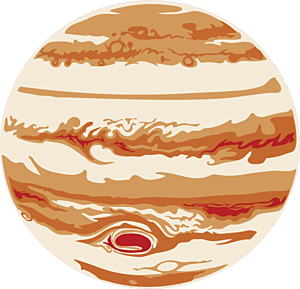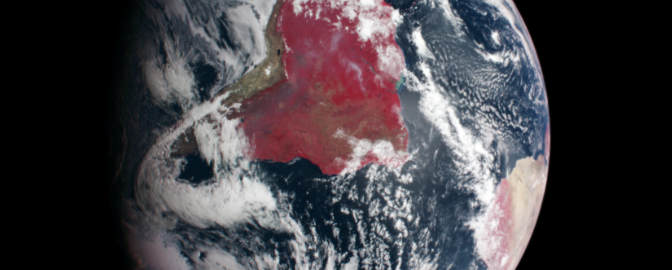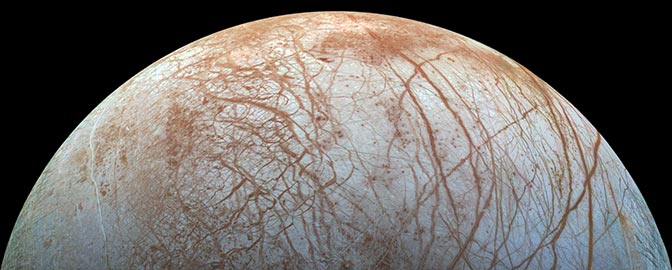The Downlink • Oct 17, 2025
Stormy weather
Space Snapshot

ESA’s ExoMars Trace Gas Orbiter captured this image of three dust devils tracking across the Martian surface in 2021. Hundreds of similar images captured by orbiters over the years have documented over a thousand tornadoes on the surface of Mars. A recent paper synthesized 20 years of images to study how strong winds behave on the red planet. Image credit: ESA/TGO/CaSSIS.
Fact Worth Sharing

Tornado-like storms happen throughout the Solar System. Extraterrestrial vortices have been observed on Mars, Jupiter, Saturn, Neptune, and even the Sun.
Mission Briefings


Saturn's moon Mimas may have an ocean. Saturn's smallest major moon (recognizable for its resemblance to the Death Star space station in the “Star Wars” universe) shows signs that it may have an ocean buried under 20 to 30 kilometers (12 to 19 miles) of ice. New research suggests that this possible ocean may be a recent development rather than a remnant of the moon’s formation. Pictured: Mimas imaged by NASA’s Cassini spacecraft. Image credit: NASA/JPL/Space Science Institute.

ESA’s exoplanet-hunting Plato mission is ready for final tests. The spacecraft is assembled and on track to launch in December 2026. It will monitor more than 150,000 stars at the same time, hunting for terrestrial planets orbiting stars similar to our Sun.

Scientists have detected water coming from comet 3I/ATLAS — and lots of it. Observations using NASA's Neil Gehrels Swift Observatory have found signs that the interstellar comet is shedding about 40 kilograms of water per second — “roughly the output of a fire hose running at full blast.”
Space Advocate Update


The Jet Propulsion Laboratory has laid off another 550 workers. An internal memo announced that there would be another 550 layoffs at JPL today, accounting for 11% of the lab's remaining workforce. The announcement emphasized that this was not the result of the current government shutdown. It is likely the result of a dearth of future projects and the continuing efforts to cancel Mars Sample Return. According to Marcia Smith at Space Policy Online, JPL's Full Time Equivalent (FTE) workforce has dropped by about 25 percent since December 2023 as a function of both layoffs and attrition.

OSIRIS-APEX has been saved. Stephen Clark of ArsTechnica is reporting that the OSIRIS-APEX mission to the asteroid Apophis — one of the many science missions targeted for termination in the FY 2026 budget request — has received official guidance to continue operations next year. That's a huge step and a positive sign that our advocacy efforts are yielding results.
From The Planetary Society


Roughly 4,000 NASA employees — over 20% of the agency — have left in the past six months. In exclusive interviews, The Planetary Society spoke with several scientists who are speaking out about the impact of the agency's mass departures. Their stories are varied — some were fired or retired early, and others took voluntary buyouts. But all of them paint a common picture: one of pointless waste, discarded expertise, and haphazard decisions. Image credit: NASA/The Planetary Society.

In the face of budget threats, NIAC scientists and engineers are still looking to the future. Each year, NASA’s Innovative Advanced Concepts program (NIAC) funds visionary ideas that could shape the future of space exploration. This week’s Planetary Radio brings you to the 2025 NIAC Symposium in Philadelphia, Pennsylvania, USA, where host Sarah Al-Ahmed introduces some of the concepts presented at this year’s event.

Chief of Space Policy Casey Dreier has been nominated for a SpaceNews Icon Award. The leader of The Planetary Society’s space policy and advocacy program has been nominated in the Individual Achievement category, alongside Jarrett Jones (who led development of Blue Origin's New Glenn rocket) and Josef Aschbacher (head of the European Space Agency). The final awards will be announced in early December.

Catch Casey Dreier on the Smart Girl Dumb Questions podcast. Casey joined host Nayeema Raza to discuss space policy, the reasons we explore, and the science that drives it all. You can find the show on Spotify, YouTube, or Apple Podcasts.

Heading to TwitchCon in San Diego, CA? Planetary Radio host Sarah Al-Ahmed will join Moohoodles for a live panel, NASA & The Planetary Society: Space, Time, and You, on Sunday, Oct. 19, 2025, from 10:15 to 11:15 a.m. PT in the NomNom Theater. Together, they’ll explore space triumphs past, present, and future, and how everyday people can help shape the next frontier. If you’re not at the event, you can also watch live at twitch.tv/nomnom.
What's Up

After sunset, find reddish Mars very low in the west and yellowish Saturn in the east. Very bright Jupiter rises around midnight and shines high overhead before dawn. In the early morning, Venus shines brightly in the east, joined by a very thin crescent Moon on Oct. 19. The Orionid meteor shower peaks overnight between Oct. 21 and 22. Learn what else to look for in October’s night skies.
Wow of the Week

If the movie “Twister” had you thinking an EF5 was the biggest tornado out there, think again. This series of images from NASA's Solar Dynamics Observatory shows a tornado-like storm in the Sun’s lower corona. This vortex is about five times the width of Earth, with plasma swirling at speeds of up to 300,000 kilometers per hour (190,000 miles per hour). Image credit: NASA/SDO/AIA/Aberystwyth University/Li/Morgan/Leonard.
Send us your artwork!
We love to feature space artwork in the Downlink. If you create any kind of space-related art, we invite you to send it to us by replying to any Downlink email or writing to [email protected]. Please let us know in your email if you’re a Planetary Society member!


 Explore Worlds
Explore Worlds Find Life
Find Life Defend Earth
Defend Earth


